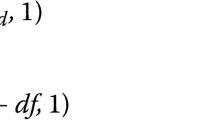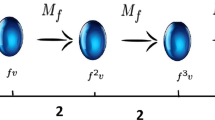Abstract
We compute quantum character varieties of arbitrary closed surfaces with boundaries and marked points. These are categorical invariants \(\int _S{\mathcal {A}}\) of a surface S, determined by the choice of a braided tensor category \({\mathcal {A}}\), and computed via factorization homology. We identify the algebraic data governing marked points and boundary components with the notion of a braided module category for \({\mathcal {A}}\), and we describe braided module categories with a generator in terms of certain explicit algebra homomorphisms called quantum moment maps. We then show that the quantum character variety of a decorated surface is obtained from that of the corresponding punctured surface as a quantum Hamiltonian reduction. Characters of braided \({\mathcal {A}}\)-modules are objects of the torus category \(\int _{T^2}{\mathcal {A}}\). We initiate a theory of character sheaves for quantum groups by identifying the torus integral of \({\mathcal {A}}={\text {Rep}}_{q}G\) with the category \({\mathcal {D}}_q(G/G)\)-mod of equivariant quantum \({\mathcal {D}}\)-modules. When \(G=GL_n\), we relate the mirabolic version of this category to the representations of the spherical double affine Hecke algebra \({\mathbb {SH}}_{q,t}\).
Article PDF
Similar content being viewed by others
Avoid common mistakes on your manuscript.
References
Ayala, D., Francis, J.: Factorization homology of topological manifolds. J. Topol. 8(4), 1045–1084 (2015)
Ayala, D., Francis, J., Tanaka, H.: Factorization homology of stratified spaces. Selecta Mathematica 23(1), 293–362 (2017)
Alekseev, A., Malkin, A., Meinrenken, E.: Lie group valued moment maps. J. Differ. Geom. 48(3), 445–495 (1998)
Bellamy, G., Ginzburg, V.: Hamiltonian reduction and nearby cycles for mirabolic D-modules. Adv. Math. 269, 71–161 (2015)
Brochier, A., Jordan, D.: Fourier transform for quantum \(D\)-modules via the punctured torus mapping class group. Quantum Topol. 8(2), 361–379 (2017)
Balagovic, M., Jordan, D.: The quantum Harish-Chandra isomorphism for \({GL}_2\). arXiv:1603.09218 (2016)
Brochier, A.: A Kohno–Drinfeld theorem for the monodromy of cyclotomic KZ connections. Commun. Math. Phys. 311, 55–96 (2012). https://doi.org/10.1007/s00220-012-1424-0
Brochier, A.: Cyclotomic associators and finite type invariants for tangles in the solid torus. Algebr. Geom. Topol. 13, 3365–3409 (2013)
Bruguières, A., Virelizier, A.: The double of a Hopf monad. arXiv preprint arXiv:0812.2443 (2008)
Ben-Zvi, D., Brochier, A., Jordan, D.: Integrating quantum groups over surfaces. J. Topology (2015) arXiv:1501.04652 (To appear)
Ben-Zvi, D., Nadler, D.: The character theory of a complex group. arXiv preprint arXiv:0904.1247 (2009)
Ben-Zvi, D., Nadler, D.: Loop spaces and representations. Duke Math. J. 162(9), 1587–1619 (2013)
Ben-Zvi, D., Nadler, D.: Betti geometric Langlands. In: Proceedings of Symposia in Pure Mathematics, vol. 97.2, pp. 3–41. AMS (2018)
Cherednik, I.: DAHA and Verlinde algebras. In: Quantum Theory and Symmetries, pp. 53–64. World Scientific Publishing, Hackensack, NJ (2004)
Cherednik, I.: Double Affine Hecke Algebras. London Mathematical Society Lecture Note Series, vol. 319. Cambridge University Press, Cambridge (2005)
Chari, V., Pressley, A.: A Guide to Quantum Groups. Cambridge University Press, Cambridge (1994)
Donin, J., Kulish, P.P., Mudrov, A.I.: On a universal solution to the reflection equation. Lett. Math. Phys. 63(3), 179–194 (2003)
Donin, J., Mudrov, A.: Explicit equivariant quantization on coadjoint orbits of \({GL}(n, {\mathbb{C}})\). Lett. Math. Phys. 62(1), 17–32 (2002)
Donin, J., Mudrov, A.: Quantum coadjoint orbits of \({GL}(n)\) and generalized Verma modules. Lett. Math. Phys. 67(3), 167–184 (2004)
Donin, J., Mudrov, A.: Quantum groupoids and dynamical categories. J. Algebra 296(2), 348–384 (2006)
Douglas, C.L., Schommer-Pries, C., Snyder, N.: Dualizable tensor categories. arXiv:1312.7188 (2013)
Etingof, P., Geer, N.: Monodromy of trigonometric KZ equations. Int. Math. Res. Not. IMRN 24, 15 (2007)
Enriquez, B.: Quasi-reflection algebras and cyclotomic associators. Sel. Math. New Ser. 13, 391–463 (2008). https://doi.org/10.1007/s00029-007-0048-2
Frohman, C., Gelca, R.: Skein modules and the noncommutative torus. Trans. Am. Math. Soc. 352(10), 4877–4888 (2000)
Finkelberg, M., Ginzburg, V.: On mirabolic D-modules. Int. Math. Res. Not. 2010(15), 2947–2986 (2010)
Freed, D.S., Hopkins, M.J., Teleman, C.: Loop groups and twisted \({K}\)-theory III. Ann. Math. 174(2), 947–1007 (2011)
Fehér, L., Klimčík, C.: Self-duality of the compactified Ruijsenaars–Schneider system from quasi-Hamiltonian reduction. Nucl. Phys. B 860(3), 464–515 (2012)
Fehér, L., Klimčík, C.: The Ruijsenaars Self-Duality Map as a Mapping Class Symplectomorphism, pp. 423–437. Springer, Tokyo (2013)
Fehér, L., Kluck, T.: New compact forms of the trigonometric Ruijsenaars–Schneider system. Nucl. Phys. B 882, 97–127 (2014)
Fock, V.V., Rosly, A.A.: Poisson structure on moduli of flat connections on Riemann surfaces and the \(r\)-matrix. In: Moscow Seminar in Mathematical Physics, vol. 191 of Am. Math. Soc. Transl. Ser. 2, pp. 67–86. Am. Math. Soc., Providence, RI (1999)
Francis, J.: The tangent complex and Hochschild cohomology of \({E}_n\)-rings. Compos. Math. 149(3), 430–480 (2013)
Fuchs, J., Schaumann, G., Schweigert, S.: A trace for bimodule categories. arXiv:1412.6968 (2014)
Gaitsgory, D.: Quantum Langlands correspondence. arXiv preprint arXiv:1601.05279 (2016)
Gan, W.L., Ginzburg, V.: Almost-commuting variety, D-modules, and Cherednik algebras. Int. Math. Res. Pap. (2006)
Ginot, G.: Notes on factorization algebras, factorization homology and applications. In: Mathematical aspects of quantum field theories, pp. 429–552. Springer (2015)
Gorsky, A., Nekrasov, N.: Relativistic Calogero–Moser model as gauged WZW theory. Nucl. Phys. B 436(3), 582–608 (1995)
Gunningham, S.: A generalized Springer decomposition for D-modules on a reductive Lie algebra. arXiv preprint arXiv:1510.02452 (2015)
Jordan, D.: Quantized multiplicative quiver varieties. Adv. Math. 250, 420–466 (2014)
Kolb, S., Stokman, J.: Reflection equation algebras, coideal subalgebras, and their centres. Sel. Math. 15(4), 621–664 (2009)
Lurie, J.: Higher algebra. http://www.math.harvard.edu/~lurie/
Lurie, J.: On the classification of topological field theories. Curr. Dev. Math. 2008, 129–280 (2009)
Nevins, T.: Mirabolic Langlands duality and the quantum Calogero–Moser system. Transform. Groups 14(4), 931–983 (2009)
Oblomkov, A.: Double affine Hecke algebras and Calogero–Moser spaces. Represent. Theory Am. Math. Soc. 8(10), 243–266 (2004)
Ruijsenaars, S., Schneider, H.: A new class of integrable systems and its relation to solitons. Ann. Phys. 170(2), 370–405 (1986)
Voronov, A.A.: The Swiss-cheese operad. In: Homotopy invariant algebraic structures (Baltimore, MD, 1998), vol. 239 of Contemp. Math., pp. 365–373. Am. Math. Soc., Providence, RI (1999)
Varagnolo, M., Vasserot, E.: Double affine Hecke algebras at roots of unity. Represent. Theory 14, 510–600 (2010)
Author information
Authors and Affiliations
Corresponding author
Rights and permissions
Open Access This article is distributed under the terms of the Creative Commons Attribution 4.0 International License (http://creativecommons.org/licenses/by/4.0/), which permits unrestricted use, distribution, and reproduction in any medium, provided you give appropriate credit to the original author(s) and the source, provide a link to the Creative Commons license, and indicate if changes were made.
About this article
Cite this article
Ben-Zvi, D., Brochier, A. & Jordan, D. Quantum character varieties and braided module categories. Sel. Math. New Ser. 24, 4711–4748 (2018). https://doi.org/10.1007/s00029-018-0426-y
Published:
Issue Date:
DOI: https://doi.org/10.1007/s00029-018-0426-y




